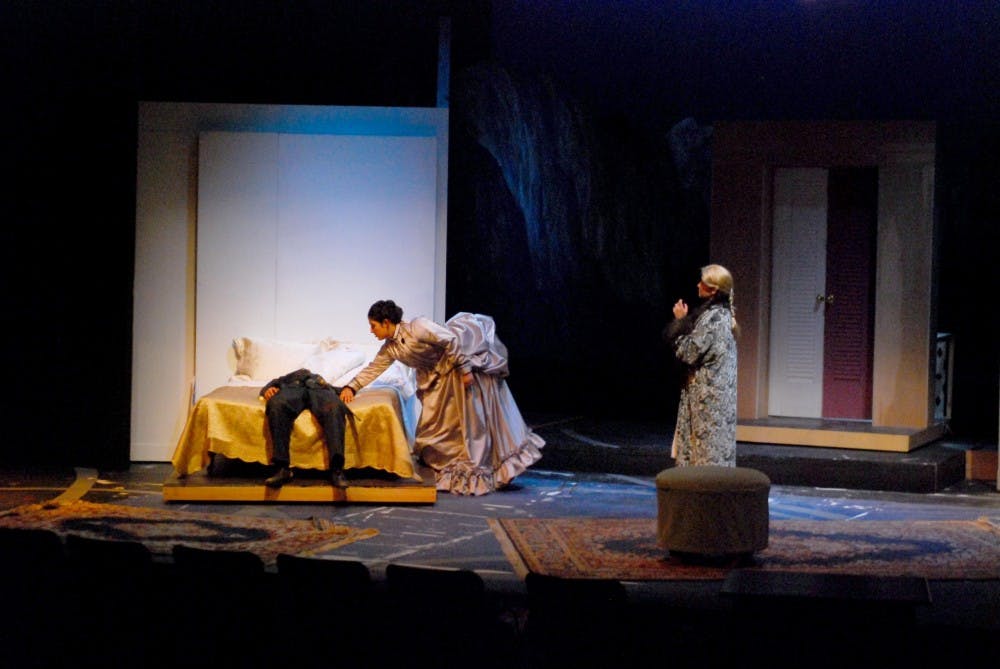A behind-the-scenes look at Mago Hunt’s latest show: “Arms and the Man”
(-- The Beacon)
By Jocelyne LaFortune Copy Editor lafortun12@up.edu
Costumes
Mago Hunt is not only home to the stage, it is also home to the costume shop where nine costume designers work long hours each week fitting and sewing costumes.
Senior Jamie Grant began working on costumes for "Arms and the Man" over the summer. As part of her senior capstone project, Grant did research in order to ensure the historical accuracy of each costume.
"This is for my capstone, so I started before school," Grant said. "I had to learn about Russia, Austria, Bulgaria and Serbia so I could understand how they interacted."
Since most of the actors have costume changes during the play, Grant estimates she and the other costume designers have constructed about 12 costumes specifically for "Arms and the Man."
"Arms and the Man" has been particularly time-consuming for the costume designers, according to costume designer Brittany Nowers, a junior.
"There are generally two main stage productions each semester," Nowers said. "Usually one is completely constructed, meaning we do all the costumes."
For the other main stage production, many of the costumes are pulled from the theater department's collection, according to Nowers.
Each costume designer puts in varying amounts of hours per week, Nowers says, with seniors spending the most hours in the shop.
"Usually seniors are encouraged to work at least 15 hours a week," Nowers said. "But you work up to that. You learn to schedule your classes around work."
Stage crew
A real-life man behind the curtain, junior Francis Finnegan, stage manager, keeps everything running smoothly, from scheduling rehearsals to calling light and sound cues.
"It's a very busy job," Finnegan said. "I make sure people are in the right place at the right time."
During each performance, Finnegan sits above the audience, giving light and sound cues to the light and sound crew.
"I'm there to make sure everything is like the director wanted it during rehearsals," Finnegan said.
In addition to giving light and sound cues, Finnegan also ensures everything, such as the sets and props, are in place before each performance begins.
Finnegan estimates he has spent approximately 18 hours per week for the last month working to make sure everything runs smoothly when it comes to performance time.
"It's my first time stage managing," Finnegan said. "I'm learning as I go."
Props
Everything on stage has to fit with the director's overall vision, right down to the bags, books and desk knickknacks.
This semester, that duty has fallen on senior Mara McGreevey, who estimates about 40 props are used in each theatrical production. With a budget of just a few hundred dollars for a main stage production – the smaller plays have a budget of $50 apiece – McGreevey works to make sure every prop on stage is appropriate for the time and place in which the play takes place.
First, McGreevey meets with the director to read the script and discuss the director's vision for the production.
"I find out if they want props that fit with the time period the play was written for, or if they'll be modifying it," McGreevey said.
Then, she starts researching.
"I start researching what would fit into that time period," McGreevey said. "So I know what would work."
After getting the director's approval on her plans, McGreevey starts the search for props. First, she looks within the theater department's store.
"We have a large repertoire of props to use," she said. "Anything I can pull from what we have, I will."
McGreevey also calls upon other members of the theater department to find props outside the department's selection. When that fails, she heads to secondhand shops and thrift stores.
"I look on eBay and at secondhand stores," McGreevey said. "Goodwill has lots of odds and ends that work really well, too."
Sometimes, however, the play will call for an unusual prop the theater department does not have, or would be too much for a limited budget.
"Once, a play called for a cat skeleton," McGreevey said. "We worked with the biology department to get one since that would have been expensive."
Director
Keeping everyone on the same page is no easy task. However, it is an important one. Graduate student Donna McFall is directing "Arms and the Man" as her thesis project.
"It's the director's job to communicate between everyone," she said. "Like a conductor in an orchestra."
Her first duty as director is to choose a play that is manageable for student actors, McFall says.
"You don't want to pick one that requires major dramatic experience, because a lot of students don't have that," she said.
Next, the director decides how he or she will interpret the play.
"Your interpretation can change the play quite a bit," McFall said. "You choose which themes you want to emphasize."
After deciding on her vision, the director meets with the costume, set, light, sound and prop designers.
"You all need to be on the same page with colors, moods, time periods and sounds," McFall said.
In addition to keeping the designers in line with her vision, the director is in charge of casting for the production.
"Different directors would cast different actors," McFall said. "I look for people whose personalities best reflect the characters. I listen to how they sound and think about how they fit together as a cast."
McFall is thankful for all the people who have worked to make "Arms and the Man" run smoothly.
"It really is a lot of work for a lot of people," she said. "All the way down to the people who serve refreshments."
(-- The Beacon)
(-- The Beacon)
(-- The Beacon)
(-- The Beacon)








